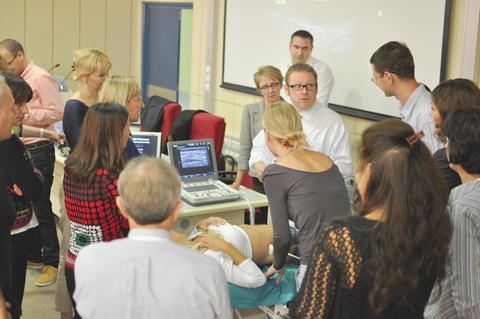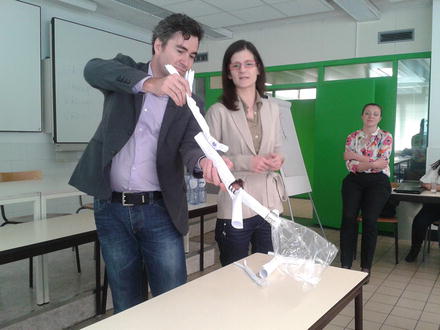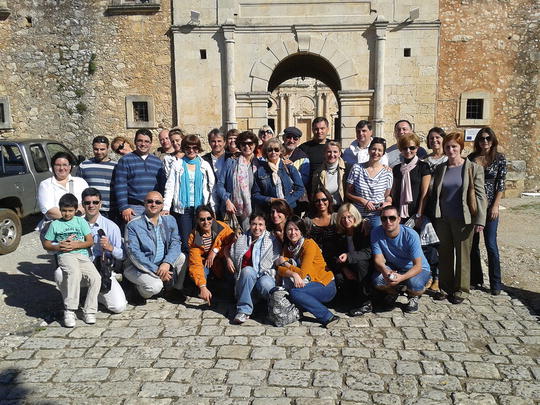Fig. 20.1
AAF Salzburg medical seminar “Severe Bleeding Management” and point-of-care testing workshop, Salzburg, Austria, July 2012
Outreach Anesthesia Team Benefit
Surgical and anesthesiology education as a part of the international mission’s curriculum with the basic aim to provide help to those who work in resource-poor areas of the world and care for underserved populations may be significant for the anesthesia professionals practicing in well-equipped and well-provided, resourceful environment. The visiting mission teams have an opportunity to learn as much as the people they are helping and teaching, because this is a two-way process [3] (Fig. 20.2). The importance is in the opportunity to practice anesthesia with a less developed technology and older generation of anesthesia drugs, which are mostly abandoned because of safety issues, new and improved products, or simply because they are much cheaper than recently developed [7]. The level of infrastructure development on the European ground, especially in the non-European Union nations are so divergent, that some of the anesthesia techniques considered as a part of anesthesia history are still in use (e.g., “blind” landmark-based regional anesthetic techniques; eliciting paresthesia regional anesthesia techniques; or “blind” central venous catheter insertion techniques etc.) [8, 9].


Fig. 20.2
International School of Obstetric Anesthesia, supported by WFSA, ultrasound guided regional anesthesia techniques workshop, Novi Sad, Serbia, September 2013
Some other areas of the less affluent world are still struggling with the lack of basic needs like running water, electric supply, oxygen, and anesthetic gas supply, as well as no physician anesthesiologists, so training and teaching experience for the anesthesia professionals in that circumstances are priceless because of the constant safety challenges of the modern world (major climate changes, tectonic disorders, terrorism, etc.) [10].
In the moderately developed, but still less-resourceful societies, there is significant experience with donation of necessary equipment and simultaneously organized training with the priority of teaching skills (operative or anesthesia technique), as opposed to just performing operations by the mission team, it is possible to achieve sustainable surgical care after missions are officially concluded [11].
The problems are ubiquitous. State-owned and public universities in less-affluent and post-“Iron-Curtain” societies, dominantly affiliated with public hospitals, have the tradition and exclusive rights in teaching and education of healthcare providers and future professional leaders. Archaic inherited rigid rules in education in former East European and Ex-Yugoslavia countries, as well as negative selection in teachers and leaders in anesthesia through generations, influenced the basic structure and moral views. Open-minded, intellectually independent individuals, exhausted by a long post-conflict period and economic transition, migrated and became part of the post-“Iron-Curtain” intellectual exodus named “Brain Drain.” A small minority made a difficult and insecure choice, to stay and try to influence the system. All the others simply “floated with the mainstream” to become a silent part of the structure.
Local Priority Change
Health authorities detected the local need for priority change and some efforts and necessary changes have been made recently, but not enough. Private initiative in the teaching and education of healthcare providers is insufficient and not nationally standardized yet. This will be hard to achieve under the present human recourse policy. Negative and intransparent human resource selection dominates in anesthesia university departments, so now they have manpower problems relating to useful applied knowledge. Real change would be electing hard working professionals and devoted teachers with the knowledge and vision to emphasize quality, safety and professionalism, together with introducing region-specific teaching methods and problem-based learning techniques [12]. Hospitals have a dramatic problem keeping a sufficient number of trained anesthesiologists. Public sector without stable funding suffers significant governmental and international creditors influence on reduction of personal incomes and on numbers employed. Added are all previous challenges that opened the space for unethical and unmoral corrupting elements. The most vulnerable part of society and the ultimate victims are the youngest, the oldest, and the critically ill part of the population [13].
Migration of Professionals
The most important and hardest part was to detect the local needs and the people willing to facilitate the transition of knowledge and practice. The demands differed in various parts of the world and depended on the stage of development and the number of educated individuals [14]. Language barriers, not enough IT trained people and prolong periods of segregation are constant problems. Even so, a number of anesthesiologists from less affluent countries participated in international trainee exchange programs, and visited a number of university hospitals with highly developed and structured educational system [10]. They acquired personal knowledge and skills and then decided to stay permanently, instead of returning to the home country. They utilized the opportunity to change a personal lifestyle and offered to their families a better and certainly more predictable future. The personal free choice cannot be questioned, but investment in that “one-way” migration has to be considered as substantial loss of human resources [15]. The legal background of those actions came along with the opening of the European borders and the establishment of a European job market for the health care professionals [16].
Teach the Teachers in Anesthesiology
The area with obvious difficulties and a huge quality and safety gap that was detected between West and the former East European nations was anesthesiology. Some original ideas of visionary people with huge experience in education and strategically guided system development, supported and funded by WFSA Education Committee and ESA later on, offered original solutions. Systematically chosen young people from former East European nations and less-affluent parts of Europe, with teaching and leading capabilities were delegated from their national anesthesia societies (Fig. 20.3). They were exposed to practice of the modern theory of teaching and adult learning in the form of originally created “Teach the Teachers” (TTT) courses and techniques, to upgrade already acquired knowledge and to adopt new and modern ways of planning, preparation, presentation, research planning, dealing with the difficulties they can meet on the way and much more [17].


Fig. 20.3
Visual aids in teaching and simulation with low resources. “Double lumen tube and one lung ventilation simulation”, by participants from Romania and Macedonia, ESA TTT course, Brussels, Belgium, April 2014
After the pilot project with participants from five national societies were concluded, more than 20 national societies delegated participants and they successfully completed the program. The graduates took the obligation to detect local anesthesia needs and to start similar TTT or the original educational programs at the national level (Fig. 20.4). This strategy gave unexpectedly quick excellent results and exceeded previous format. Because of the high accomplished standards and excellent feedback from previous participants, a great number of other European nations asked to participate. Not all of the national teams gave the same results, but all have produced a substantial quality change in teaching and started the mission in their home countries. The graduates remain connected in between and have created a network of people with the same goal, to raise the level of education and anesthesia practice. They organized international events with the participants from the region, and hosted a number of quality CME programs: seminars, workshops, national congresses which created a “snowball effect.”





Fig. 20.4
European ISIA 3 (TTT) Course, cofounded by WFSA and ESA, Crete, Greece 2012. Participants from Latvia, Lithuania, Georgia, Croatia, Greece, Turkey, and Malta

Full access? Get Clinical Tree






